|

 Up
Up 
 Patents and
Patents and
Politics

(You are here.)



  Need
to Need
to
find your
bearings?
Try
these
navigation aids:
If
this is your first
visit, please stop by:
Something
to share?
Please:



|
|
Available in Française, Español, Português, Deutsch, Россию,
中文,
日本, and others.
 ahm's
and Walcott's distortion of the 1914 test-flights and the
unwarranted conclusion that the Langely Aerodrome A was
airworthy in its original 1903 configuration was repeated in
hundreds of newspapers and magazines worldwide. The Wrights’ English
patent attorney, Griffith Brewer, visited the Curtiss camp on Lake
Keuka in mid-June, took some photos to document the changes that had
been made to the Aerodrome, and fired off a letter to the New York
Times on 22 June 1914 that exposed the deception. In his letter,
Brewer asked some embarrassing questions: ahm's
and Walcott's distortion of the 1914 test-flights and the
unwarranted conclusion that the Langely Aerodrome A was
airworthy in its original 1903 configuration was repeated in
hundreds of newspapers and magazines worldwide. The Wrights’ English
patent attorney, Griffith Brewer, visited the Curtiss camp on Lake
Keuka in mid-June, took some photos to document the changes that had
been made to the Aerodrome, and fired off a letter to the New York
Times on 22 June 1914 that exposed the deception. In his letter,
Brewer asked some embarrassing questions:
- "Why has Langley's most interesting machine been taken out
of the Smithsonian and altered from its original historic state
to try to make it fly?
- "Why if such a demonstration were decided upon, was not some
impartial, unprejudiced person chosen to make the test instead
of the person who has been found guilty of infringement of the
Wright Patent?
- "Why, if the Langley flying machine was a practical flying
machine, did not those in charge of the machine try to fly it
without alteration? ...This should have been easy if the machine
invented by Professor Langley was really capable of flight."
This, in turn, it generated a controversy that raged for nearly
thirty years in the popular press. Instead of vindicating Langley,
it eventually wedded his name to a failure that overshadowed his
many successes and diminished the scientific institution he had once
led.
The media was
quick to understand why Curtiss had staged this event.
In 1909, the
Wright brothers filed a legal suit against Curtiss and his company
for infringement of their patent. The Wright brothers and Curtiss
had been duking it out in the courts ever since, with injunctions,
depositions, expert testimonies, and years of legal delays. In 1913,
Judge John R. Hazel of the United States District Court for the
Western District of New York had decided for the Wrights and in
early 1914 Curtiss lost his last possible appeal. According to the media, he
was on the ropes; the continued existence of the Curtiss Aeroplane
and Motor Company in doubt unless he could come up with a good
reason to reopen the case. On 5 June 1914, Flight
magazine had observed, “This test has a purpose in view besides
vindicating Langley. It is held by this proof of the capability of
the Langley machine to fly, certain patent claims can be
successfully overcome.”
This was just
what Curtiss' lead attorney W. Benton Crisp was planning. The Wright
patent described an aircraft control system. If a successful example
of airplane controls that predated the Wrights – the legal term was
"prior art" – could be found, then it could be argued that the
Wrights had no right to the broad claims they were making for their
patent. In fact, Curtiss and Crisp did not intend to rely on only
one example. In addition to the Langley Aerodrome, Curtiss would
also eventually build a replica of an airplane designed in 1883 by Alexandre Goupil. It had "elevons," precursors to the ailerons that
Curtiss used for roll control.
The motives of
the Smithsonian Institution were less clear. The manned Aerodrome
A was a technological dead end; the few successful unmanned
aerodromes that Langley had flown in 1896 and afterwards did not
influence the development of aeronautics except to inspire a few
early aviators, among them the Wright brothers. Why had Secretary
Walcott and the Smithsonian risked their reputations by revisiting a
failed experiment just to “vindicate” a dead colleague?
The
question was its own answer. Reputation was the coin of the realm in
Washington DC, then as it is now. The stated purpose of the
Smithsonian may have been to advance and share scientific knowledge,
but it existed in a city that ran on politics. Secretary Walcott may
have been an accomplished paleontologist, but he was also a highly
effective politician. And he was effective because he had carefully
groomed his reputation. He had just one outstanding blemish that
limited his potency in his current position – the failure of the
Langley Aerodrome.
|
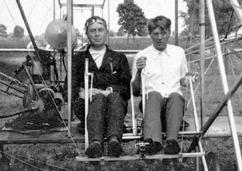
Griffith Brewer (left) being taught to fly by instructor Max
Rinehart (right) at the Wright Flying School in 1913. Brewer was
also an experienced balloonist.
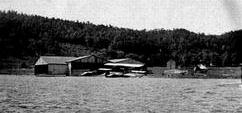
One of Brewer's photos from June 1914 showing the Curtiss sheds on
the shore of Lake Keuka. The Aerodrome is on the right, under a
tarp.
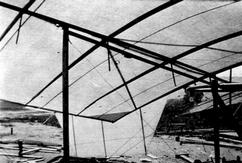
Showing the double spars that stiffened the wings. Curtiss had added
a short spar beneath each wing.
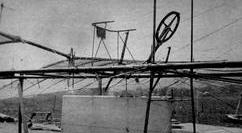
Curtiss controls in the Aerodrome. The post moved the tail to
control pitch; the shoulder yoke and then the wheel moved the
mid-ships rudder to control yaw. Later the rudder was tied off and
the tail made to move both up and down and side to side.
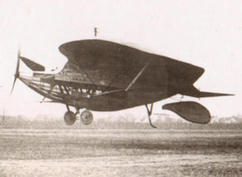
The Curtiss Duck -- an inexact copy of an aircraft designed in 1883
by Alexandre Goupil -- in flight at the Curtiss facility near
Newport News in January 1917.
|